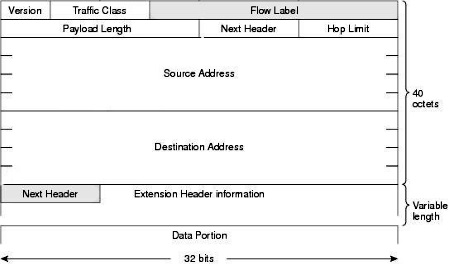
The IPv6 Payload Length field is a 16-bit field that indicates the length in bytes of just the payload following the main IPv6 header or, in other words, the data portion of the packet. It does not include the main IPv6 header. If the IPv6 packet has one or more extension headers, they are included in the number of bytes contained in the Payload Length field. Extension headers are considered part of the payload.
| IPv6 Header | IPv6 Extension Header (Optional) | Data |
The IPv6 Payload Length field is similar to the Total Length field in the IPv4 header, except for one important difference: IPv4's Total Length field includes both the IPv4 hLength field specifies only the number of bytes of data or payload; it does not include the main IPv6 header. The IPv4 header can vary in length because of the Padding and Options fields, whereas the IPv6 header is fixed at 40 bytes.
Note: The calculation to determine the number of bytes in the IPv4 payload (data) following the IPv4 header is IPv4 Total Length - IPv4 IHL = number of bytes in the IPv4 payload (data). Remember that the IPv4 IHL field is in 32-bit words, whereas the IPv4 Total Length field is in bytes.
As mentioned earlier, IPv4 Total Length is a 16-bit field, therefore allowing for IPv4 packet sizes up to 65,355 bytes. In reality, these packet sizes are much smaller due to the maximum transmission unit (MTU) of the links. IPv4 has no options for exceeding this theoretical limit. However, IPv6 does have the ability to carry larger payloads. This type of packet is known as a jumbogram, as described in RFC 2675, IPv6 Jumbograms. A jumbogram is an IPv6 packet that contains a payload greater than 65,535 bytes, the maximum allowed with the 16-bit IPv6 Payload Length field.
Jumbograms use the Jumbo Payload option in the Hop-by-Hop extension header, which is described later in this chapter. The Jumbo Payload option uses a 32-bit-length field to allow transmission of IPv6 packets with payloads between 65,536 and 4,294,967,295 (232-1) bytes (4 GB-1).
As with IPv4, the size of IPv6 packets is still limited by today's link layer MTUs. However, IPv6 jumbograms are being used for fast links inside or between supercomputers.
About the Author
Rick Graziani has been an instructor of computer networking and computer science courses at Cabrillo College in Aptos, California since 1994. Rick also teaches networking courses in the Computer Engineering department at the University of California, Santa Cruz and is on the Curriculum Engineering team for Cisco Networking Academy.
Organizations are increasingly transitioning to IPv6, the next generation protocol for defining how devices of all kinds communicate over networks. Now fully updated, IPv6 Fundamentals offers a thorough, friendly, and easy-to-understand introduction to the knowledge and skills you need to deploy and operate IPv6 networks.
Leading networking instructor Rick Graziani explains all the basics simply and clearly, step-by-step, providing all the details you'll need to succeed. You'll learn why IPv6 is necessary, how it was created, how it works, and how it has become the protocol of choice in environments ranging from cloud to mobile and IoT.
Graziani thoroughly introduces IPv6 addressing, configuration options, and routing protocols, including EIGRP for IPv6, and OSPFv3 (traditional configuration and with address families). Building on this coverage, he then includes more in-depth information involving these protocols and processes.
This edition contains a completely revamped discussion of deploying IPv6 in your network, including IPv6/IPv4 integration, dynamic address allocation, and understanding IPv6 from the perspective of the network and host. You'll also find improved coverage of key topics such as Stateless Address Autoconfiguration (SLAAC), DHCPv6, and the advantages of the solicited node multicast address.
Throughout, Graziani presents command syntax for Cisco IOS, Windows, Linux, and Mac OS, as well as many examples, diagrams, configuration tips, and updated links to white papers and official RFCs for even deeper understanding.
• Learn how IPv6 supports modern networks encompassing the cloud, mobile, IoT, and gaming devices
• Compare IPv6 with IPv4 to see what has changed and what hasn't
• Understand and represent IPv6 addresses for unicast, multicast, and anycast environments
• Master all facets of dynamic IPv6 address allocation with SLAAC, stateless DHCPv6, and stateful DHCPv6
• Understand all the features of deploying IPv6 addresses in the network including temporary addresses and the privacy extension
• Improve operations by leveraging major enhancements built into ICMPv6 and ICMPv6 Neighbor Discovery Protocol
• Configure IPv6 addressing and Access Control Lists using a common topology
• Implement routing of IPv6 packets via static routing, EIGRP for IPv6, and OSPFv3
• Walk step-by-step through deploying IPv6 in existing networks, and coexisting with or transitioning from IPv4
Reader Lucas Schultz says, "If you are looking to take the CCNA and IPv6 is not clear to you after Cisco material, this is the book you. This is the best in depth discuss about IPv6 how it works and the mechanisms to make it work. Author made it very easy to read and understand. Highly recommend this book to IT personnel or CCNA certification.



